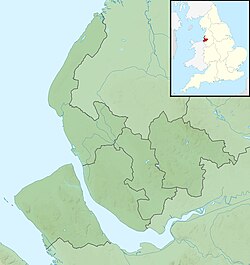History
In the 18th Century, vessels arriving in the Port of Liverpool were required to first deposit their gunpowder in the Gunpowder magazine, which was located in a secluded area on the Wirral, across the River Mersey from Liverpool. Over time, Magazine Village developed, and it was here that the Liverpool Dock Trustees placed one of their lifeboats in 1827, with a boathouse being constructed in 1828. The location was ideally situated to cover the mouth of the river. A second boat was stationed there in 1839. [3]
At a public meeting in 1862, it was discussed that a boat, located in the now increasingly populous area known as New Brighton, would be better positioned to effect a faster response into Liverpool Bay. The RNLI was approached, and agreed to provide a lifeboat station in New Brighton. An unusual new 'Tubular' type of lifeboat, named Rescue, was commissioned with J. Hamilton, Jnr, Windsor Works, Liverpool, and arrived on station in January 1863. [4]
Within 18 months, as the Liverpool Dock Trustees had found, it was necessary to place a second boat at New Brighton, and a No.2 station was started in July 1864. This boat too was unusual, as it was a 33-foot Iron boat rather than the usual wooden boats. She was named Willie and Arthur. [4]
In 1893, New Brighton received the Duke of Northumberland (ON 231), transferred from Holyhead to be the No.2 lifeboat. The boat was a 50-foot Steam-powered lifeboat, using Water-Jets as a means of propulsion, over 140 years before this technology was again utilised by the RNLI in the present day Shannon-class lifeboats. When the boat was required to be returned to Holyhead, the RNLI commissioned another Steam-class lifeboat. Arriving on station in 1897, she was named Queen (ON 404) to celebrate the Diamond Jubilee of Queen Victoria. [4]
The 60-foot Barnett-class lifeboat William and Kate Johnston (ON 682), replacement for Queen, was assigned to be the No.1 station boat in 1938.
Both No.1 and No.2 station boats were retired in 1950, being replaced by just one boat, effectively closing the No.2 station. The 52-foot Barnett-class lifeboat Norman B. Corlett (ON 883) remained in service until 1973, when it was decided that the All-weather lifeboat would be withdrawn, and replaced with a fast Inshore B-class (Atlantic 21). With the Atlantic-class boat having to be stored 1.5 miles from the station until a new boathouse was built, a D-class (RFD PB16) lifeboat was also placed on service for 18 months.
In response to the number of rescues required on the large expanse of mud and sand at the end of the Wirral Peninsular, the RNLI placed one of their seven Griffon Hoverwork Type 470TD Hovercraft on station in 2004. This Hovercraft was relocated to Hoylake in 2016.
This page is based on this
Wikipedia article Text is available under the
CC BY-SA 4.0 license; additional terms may apply.
Images, videos and audio are available under their respective licenses.


